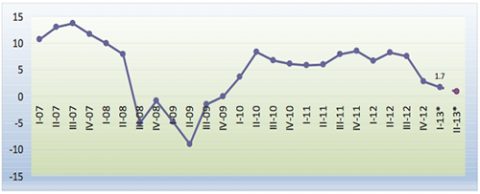It is an empirical fact that in market economies the economic activity shows cyclical patterns. The 19th century French economist Clement Juglar is generally attributed with having formulated the first coherent theory of what are known as business cycles. According to Juglar, the cyclical fluctuations are caused through lags in the adjustment of production.
In a market economy, there is no central planner with a birds-eye view on the whole economic system. Rather, what is produced in the economy is decided in an entirely decentralized manner through the simultaneous decision making of many entrepreneurs. Yet each of these entrepreneurs has only limited information on the trends of supply and demand in the different markets, and due to their ignorance they must heavily rely on the prices of goods as indicators of scarcity. When prices for a commodity are above its long-run production costs, this signals to entrepreneurs that there is an excess of demand over supply. Striving to make profits, they will install production capacities for closing this gap. This is the time of economic upturn.
These investments, however, take time to be realized, and it takes even more time for the shortages on the markets to disappear. A manufacturing plant is not set up in a fortnight, and when it has finally been built, it may still take long to get the production process going. During all this time, prices remain high, signaling to suppliers that there may still be a shortage. More and more entrepreneurs smell the money, set up production capacities, and… face a rude awakening!
The rude awakening comes when prices begin to decline. The investments already underway cannot be halted instantaneously, so that even though prices are falling – possibly below the long-run production costs – larger amounts of the previously scarce commodities still flow into the market. Instead of the desired profits, heavy losses accrue. Bankruptcies, layoffs, and credit defaults follow soon, and the recession has arrived. Yet also recession is only temporary, as – once the supply has been reduced sufficiently – the investment dynamic will start again!
A PURE COORDINATION PROBLEM?
If Juglar identified the true causes for business cycles, the problem could easily be solved in a planned economy. The central planner would know the production capacity that is about to be installed, and he would make sure that these capacities do not exceed the demand on the market. Even though the famous British economist John Maynard Keynes did not want to switch to a planned economy, like Juglar he considered business cycles to be essentially caused through the coordination failure of economic agents, and he proposed to alleviate this problem by targeted government interventions. These would slow down economic activities when the economy was heating up, and it would stimulate activity when a recession was on the way.
Not everybody does agree, however, that business cycles have no other reasons but the decentralized decision making in a market economy. The contemporary economists Finn E. Kydland from Norway and Edward C. Prescott from the United States see evidence that business cycles are in fact optimal reactions of the economy to exogenous factors. Such factors could for example be the supply of raw materials, demographic changes, and natural disasters. According to their real business cycle theory, any efficient economy must cyclically shrink and expand like an elastic spring. A central planner would also generate cyclic dynamics if the production plans were adjusted optimally.
WHERE IS GEORGIA STANDING IN THE BUSINESS CYCLE?
In the end of April, the National Statistics Office of Georgia (NSO) published the preliminary evaluations of the gross domestic product (GDP) growth for March and the first quarter of 2013. According the forecast of the NSO, the GDP growth rate for the 1st quarter of 2013 is just 1.7%, and in March the economic growth rate stood at abysmal 0.2%. Moreover, the value added tax turnover has decreased by 3.2% year-on-year basis, which is a direct indicator for a reduced willingness to spend among consumers. Also the Consumer Confidence Index (CCI) of ISET captured this tendency, as it declined in March as well. The CCI trend is particularly worrying, as it is not only based on the consumers’ assessments of the current situation, but also on their expectations. As a forward-looking indicator, it reveals that consumers are becoming increasingly pessimistic.
Like in the preceding 15 months, Georgia experienced deflation also in March 2013. The consumer price index decreased by 2.1% year-on-year basis. Also the producer price index declined by 0.4%. As we reported repeatedly in the previous weeks, also our Khachapuri Index, measuring the prices of a consumption basket that contains basic foodstuff, reflected the deflation.
RECESSION OR NOT?
There is no doubt that Georgia’s economic growth has fallen significantly and the country experiences deflation. Is this the start of a recession? While it is not trivial to answer this question, we are inclined to think that this is not the case. There are several potential factors unrelated to the business cycle that might play a role, and if these would be responsible for the current stagnation, it would not qualify as an upcoming recession. In fact, economic activity could pick up again swiftly when these factors disappear.
The most important influence that might handicap economic growth is the ongoing political uncertainty that originated with the last parliamentary election in October 2012. As Georgia’s society is highly politicized, political events have sizable impacts on general macroeconomic developments. A turbulent political situation can negatively affect the economic agents’ spending behavior and, even more so, domestic and foreign investment.
Another factor could be the somewhat puzzling impotence of monetary policy that can currently be observed. During the deflation period, the National Bank of Georgia gradually lowers interest rates in order to reduce the cost of capital, push prices up, and reach its inflation target of 6%. Indeed, the interest rates have declined by 0.4 percentage points. Yet since 15 months there is deflation in Georgia, and the monetary counter measures do not take effect.
A further reason could be the persistently ambivalent state of the world economy that is spilling over to Georgia. Georgia’s international trade has reduced in March, as both exports and imports fell by approximately 10%. Likewise, 2012 foreign direct investments fell by 17% year-on-year basis.
Growth of the Georgian gross domestic product in percentage terms, 2007-2013
Looking at the chart, we see that the last recession in Georgia was in the year 2009. It was arguably triggered through the war with Russia as well as through the global financial crisis. If it was the start of a Juglar Cycle, it would be unlikely to see the next recession after 5 years. A Juglar Cycle usually lasts between 7 and 11 years, and so the time simply seems not yet ripe for a new recession.
The present blog post is based on the monthly macroeconomic review (in Georgian language) of ISET-PI.

















Comments